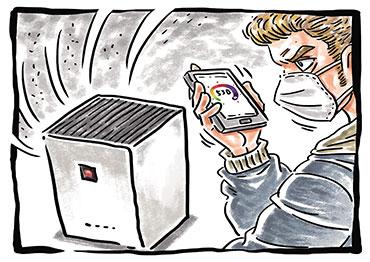ong before the time of Covid-19, foreigners in Beijing were discussing which face mask offered the most protection – not from viruses, but from PM2.5, the tiny pollution molecules in the air that can easily penetrate your lungs and enter your bloodstream.
Following a familiar pattern, at first maskwearers were ridiculed as obsessives and hypochondriacs. Then masks became a fashion statement, and status symbol.
Mask wearing quickly took hold in a certain segment of the population that rode fixed-gear bicycles and enjoyed craft beer.
Soon, people were trading information on where to get replacement charcoal filters for the stylish black polyethylene masks that looked like they came from a science-fiction dystopia.
People in the know were discussing the differences between boutique European air filter machines in the same way they discussed the differences between Grey Goose and Ketel One vodka.
In time, face masks become de rigueur for foreigners.
People started to call ahead to restaurants to see if they had air purifiers.
The most elite private schools created tented areas with filtered air so children could play “outdoors.”
Concern about air pollution even made a local doctor a celebrity. This doctor blogged reassuringly about which face masks best combated air pollution, and ran his own scientific tests on the efficacy of various air purifiers. (The boutique European ones worked best.)
But mostly he assuaged the guilt of working expat parents concerned their decision to work in Beijing was harming their families.
I always sympathized with women who experienced moodiness due to their periods, but I never really empathized until the “Airpocalypse” era when air pollution levels were off the charts.
I mean off the charts literally – the standard Air Quality Index was designed with a maximum reading of 500. Its designers did not foresee a need for anything higher.
I noticed that on bad pollution days, I was prone to mood swings, irritability, headaches and greasy hair. And so was everyone else. It was as if the whole city was having PMS. In time, I developed a persistent cough and pain in my lungs. I consulted a doctor about it several times, and he told me, “Don’t worry about it, this is happening to everyone.”
I did not find this reassuring, and moved out of Beijing to the beautiful city of Dali in Yunnan Province.
Dali’s beauty was creating new problems. People were flooding into the city from around China, to escape air pollution and other stresses of big city life.
The population sharply rose, and out-oftowners leased all the property along the shore of Erhai Lake. They built the boutique hotels of their dreams, often named after hotels and restaurants from idealized Japanese television shows and movies. This boosted the local economy but put stress on the environment.
In Dali, I liked to swim in the lake every day, but I had to avoid giant algae blooms along the shore.
The blooms were created by a combination of factors including excess runoff from farmers fields, threatening the lake’s longterm health.
In 2013, environmental degradation became so serious a tipping point was crossed. China declared a “war on pollution.”
I witnessed the battle first-hand in Dali.
Boats were banned from Erhai, including large cruisers catering to tourists and small metal rowboats used for fishing.
Any building constructed too close to the lake was demolished, without exception.
This led to the striking site of many dream hotels being half-demolished – the parts that were far enough away were allowed to stand.
Over the next few years, the government installed a proper sewage system along the lake and built a scenic road for tourists. By all appearances, the water is clearer and cleaner, and the local government’s efforts to improve water quality are ongoing. It’s heartening to see the results of large-scale restrictions on pollution.

 Old Version
Old Version